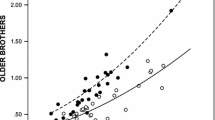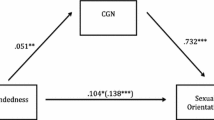Abstract
Western studies have consistently found that androphilic (sexually attracted to men) male-to-female transsexuals have a later birth order and a relative excess of brothers compared with appropriate control participants. However, non-Western studies on birth order and sibling sex ratio in androphilic males (transsexual or non-transsexual) are rare. The objective of the study was to test the hypothesis that androphilic male-to-female transsexuals have a late birth order and a relative excess of brothers in a non-Western culture with a higher fertility rate. The participants were 60 androphilic male-to-female transsexuals and 61 male heterosexual controls. The transsexual participants had significantly more older brothers than the control participants, but the groups did not differ in their numbers of older sisters, younger brothers, or younger sisters. The foregoing pattern is usually referred to as the “fraternal birth order effect.” Slater’s and Berglin’s Indexes both showed that the mean birth order of the control participants was very close to that expected from a random sample drawn from a demographically stable population whereas the mean birth order of the transsexual participants was later. A measure of sibship composition, brothers/all siblings, showed that the transsexual group had a higher proportion of male siblings compared with the control group. In conclusion, the present study found that Turkish androphilic male-to-female transsexuals show the same high fraternal birth order that has been found in comparable androphilic samples in Western Europe, North America, and the South Pacific, which suggests a common underlying biological causal mechanism.
Similar content being viewed by others
References
American Psychiatric Association. (2000). Diagnostic and statistical manual of mental disorders (Fourth ed., text rev.). Washington, DC: Author.
American Psychiatric Association. (2013). Desk reference to the diagnostic criteria from DSM-5. Arlington, VA: Author.
Aydin, H., & Gulcat, Z. (2003). Turkey. In R. T. Francoeur & R. J. Noonan (Eds.), Continuum complete international encyclopedia of sexuality (pp. 1054–1073). New York: The Continuum International Publishing Group.
Bartlett, N. H., & Vasey, P. L. (2006). A retrospective study of childhood gender-atypical behavior in Samoan fa’afafine. Archives of Sexual Behavior, 35, 659–666.
Berglin, C. G. (1982). Birth order as a quantitative expression of date of birth. Journal of Epidemiology and Community Health, 36, 298–302.
Blanchard, R. (1997). Birth order and sibling sex ratio in homosexual versus heterosexual males and females. Annual Review of Sex Research, 8, 27–67.
Blanchard, R. (2004). Quantitative and theoretical analyses of the relation between older brothers and homosexuality in men. Journal of Theoretical Biology, 230, 173–187.
Blanchard, R. (2008). Review and theory of handedness, birth order, and homosexuality in men. Laterality, 13, 51–70.
Blanchard, R., & Lippa, R. A. (2007). Birth order, sibling sex ratio, handedness, and sexual orientation of male and female participants in a BBC internet research project. Archives of Sexual Behavior, 36, 163–176.
Blanchard, R., & Sheridan, P. M. (1992). Sibship size, sibling sex ratio, birth order, and parental age in homosexual and nonhomosexual gender dysphorics. Journal of Nervous and Mental Disease, 180, 40–47.
Blanchard, R., Zucker, K. J., Bradley, S. J., & Hume, C. S. (1995). Birth order and sibling sex ratio in homosexual male adolescents and probably prehomosexual feminine boys. Developmental Psychology, 31, 22–30.
Blanchard, R., Zucker, K. J., Cohen-Kettenis, P. T., Gooren, L. J. G., & Bailey, J. M. (1996). Birth order and sibling sex ratio in two samples of Dutch gender-dysphoric homosexual males. Archives of Sexual Behavior, 25, 495–514.
Bogaert, A. F. (1998). Birth order and sibling sex ratio in homosexual and heterosexual non-white men. Archieves of Sexual Behavior, 27, 467–473.
Bogaert, A. F. (2006). Biological versus nonbiological older brothers and men’s sexual orientation. Proceedings of the National Academy of Sciences of the United States of America, 103, 10771–10774.
Bogaert, A. F., & Skorska, M. (2011). Sexual orientation, fraternal birth order, and the maternal immune hypothesis: A review. Frontiers in Neuroendocrinology, 32, 247–254.
Bozkurt, A., Isikli, H., Demir, F., Ozmenler, K. N., Gulcat, Z., Karlidere, T., et al. (2006). Body image and personality traits of male-to-female transsexuals and homosexuals. Social Behavior and Personality, 34, 927–938.
Bradford, N. J. (1983). Transgenderism and cult of Yellamma: Heat, sex, and sickness in south Indian ritual. Journal of Anthropology Research, 39, 307–322.
Coleman, E., Colgan, P., & Gooren, L. (1992). Male cross-gender behavior in Myanmar (Burma): A description of the acault. Archieves of Sexual Behavior, 21, 313–321.
Gomez-Gil, E., Esteva, I., Carrasco, R., Almaraz, M. C., Pasaro, E., Salamero, M., et al. (2011). Birth order and ratio of brothers to sisters in Spanish transsexuals. Archives of Sexual Behavior, 41, 541–549.
Green, R. (2000). Birth order and ratio of brothers to sisters in transexuals. Psychological Medicine, 30, 789–795.
Jackson, P. A. (1997). Thai research on male homosexuality and transgenderism and the cultural limits of Foucaultian analysis. Journal of History of Sexuality, 8, 52–85.
Jones, M. B., & Blanchard, R. (1998). Birth order and male homosexuality: Extension of Slater’s index. Human Biology, 70, 775–787.
MacCulloch, M. J., & Waddington, J. L. (1981). Neuroendocrine mechanisms and etiology of male and female homosexuality. British Journal of Psychiatry, 139, 341–345.
MacFarlane, D. F. (1984). Transsexual prostitution in New Zealand: Predominance of persons of Maori extraction. Archieves of Sexual Behavior, 13, 301–309.
Nanda, S. H. (1994). An alternative sex and gender role in India. In G. Herdt (Ed.), Third sex, third gender: Beyond sexual dimorphism in culture and history (pp. 373–417). New York: Zone Books.
Ozgur, E. M. (2004). Spatial distribution of total fertility rate in Turkey. Cografi Bilimler Dergisi, 2(2), 1–12. doi:10.1501/Cogbil_0000000047.
Poasa, K. H., Blanchard, R., & Zucker, K. J. (2004). Birth order in transgendered males from Polynesia: A quantitative study of Samoan fa’afafine. Journal Sex and Marital Therapy, 30, 13–23.
Purcell, D. W., Blanchard, R., & Zucker, K. J. (2000). Birth order in a contemporary sample of gay men. Archieves of Sexual Behavior, 29, 349–356.
Schagen, S. E. E., Delemarre-van de Waal, H. A., Blanchard, R., & Cohen-Kettenis, P. T. (2012). Sibling sex ratio and birth order in early-onset gender dysphoric adolescents. Archives of Sexual Behavior, 41, 541–549.
Slater, E. (1958). The sibs and children of homosexuals. In D. R. Smith & W. Davidson (Eds.), Symposium on nuclear sex (pp. 79–83). London: Heinemann.
Slater, E. (1962). Birth order and maternal age of homosexuals. Lancet, 1, 69–71.
The World Bank Group. (2014). Fertility rate, total (births per woman). Retrieved from http://data.worldbank.org/indicator/SP.DYN.TFRT.IN?page=2.
The World Factbook 2013–14. (2013). Washington, DC: Central Intelligence Agency. Retrieved from https://www.cia.gov/library/publications/the-world-factbook/index.html.
Tsoi, W. F., Kok, L. P., & Long, F. Y. (1977). Male transsexualism in Singapore: A description of 56 cases. British Journal of Psychiatry, 131, 405–409.
VanderLaan, D. P., & Vasey, P. L. (2011). Male sexual orientation in Independent Samoa: Evidence for fraternal birth order and maternal fecundity effects. Archives of Sexual Behavior, 40, 495–503.
VanderLaan, D. P., & Vasey, P. L. (2013). Birth order and avuncular tendencies in Samoan men and Fa’afafine. Archives of Sexual Behavior, 42, 371–379.
Vasey, P. L., & VanderLaan, D. P. (2007). Birth order and male androphilia in Samoan fa’afafine. Proceedings of the Royal Society of Biological Sciences, 274, 1437–1442.
Westphal-Hellbusch, S. (1997). Institutionalized gender-crossing in southern Iraq. In S. O. Murray & W. W. Roscoe (Eds.), Islamic homosexualities (pp. 233–243). New York: New York Universities Press.
Wikan, U. (1977). Man becomes woman: Transsexualism in Oman as a key to gender roles. Man, 12, 304–319.
Zucker, K. J., & Blanchard, R. (1994). Re-analysis of Bieber et al.’s 1962 data on sibling sex ratio and birth order in male homosexuals. Journal of Nervous and Mental Disease, 182, 528–530.
Zucker, K. J., Blanchard, R., Kim, S. T., Pae, C., & Lee, C. (2007). Birth order and sibling sex ratio in homosexual transsexual South Korean men: Effects of the male preference stopping rule. Psychiatry and Clinical Neurosciences, 61, 529–533.
Zucker, K. J., Green, R., Coates, S., Zuger, B., Cohen-Kettenis, P. T., Zecca, G. M., … Blanchard, R. (1997). Sibling sex ratio of boys with gender identity disorder. Journal of Child Psychology and Psychiatry, 38, 543–551.
Acknowledgments
The authors thank Hasmet Isikli, M.D., who first gave the opinion to study transsexuals and birth order. They also thank all persons and especially Mehmet Ak, M.D., and K. Nahit Ozmenler, M.D., from Gulhane School of Medicine Department of Psychiatry, who supported the study.
Author information
Authors and Affiliations
Corresponding author
Rights and permissions
About this article
Cite this article
Bozkurt, A., Bozkurt, O.H. & Sonmez, I. Birth Order and Sibling Sex Ratio in a Population with High Fertility: Are Turkish Male to Female Transsexuals Different?. Arch Sex Behav 44, 1331–1337 (2015). https://doi.org/10.1007/s10508-014-0425-9
Received:
Revised:
Accepted:
Published:
Issue Date:
DOI: https://doi.org/10.1007/s10508-014-0425-9




